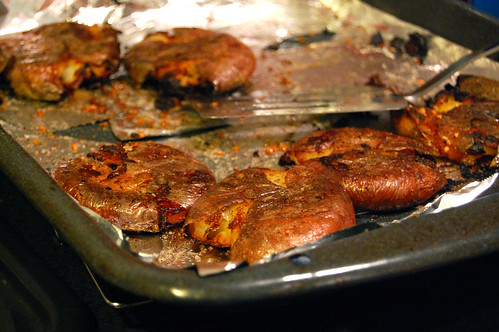
Don't get me wrong, it is easy. It's just more dishwashing than I would like. :D Still, the results are so spectacular that I can't really complain. Start with good tomatoes. I used tomatoes from my garden -- a few of the larger ones that actually ripened during our cold Seattle summer. The garlic and basil were also from my garden, I'm proud to say!

Start by roasting the tomatoes, garlic, and onion with salt, pepper, and olive oil. Once the tomatoes are nice and soft, puree them with the garlic, onion, and some basil. I used my new immersion blender, but this can also be done in a regular blender or a food processor.

This next step, in my opinion, is not really optional. After the tomato mixture has been pureed, strain it through a fine mesh sieve. All the little bits of tomato skin and things that didn't get finely pureed get separated out, making the resulting soup wonderfully smooth in texture. To this I added soy milk (substituting for heavy cream with no ill effect, though I'm sure it would have been even more delicious with the cream), a splash of white wine, and a pinch of sugar. I like my soups very hot, so I strained the soup into a small pot and kept it on low heat while I prepared the other part of dinner -- what's tomato soup without grilled cheese?

In this case, it was a grilled cheese sandwich made from a plain bagel and Irish white cheddar. It was the only kind of bread I had, but it worked great. Excellent dunkability. A fantastic complement to the deep, rich flavor of the soup. :-) The recipe I provide makes one large bowl, or two smaller ones. If you decide to double or even triple it, to make all the dishes worth it, keep in mind you'll probably have to puree and strain in batches.

Creamy Tomato Bisque
Ingredients
- 4 large tomatoes, cored
- 4 cloves of garlic, peeled
- 1/4 of an onion, chopped
- salt
- pepper
- olive oil
- 1 tbsp basil, sliced or chopped
- a splash of white wine (optional)
- a big pinch of sugar
- 1/4 to 1/2 cup heavy cream (can be substituted with milk)
- Preheat the oven to 375°F.
- Line a baking sheet with foil. Place the cored tomatoes on the sheet. Partially wrap garlic and onion in some foil. Sprinkle salt and pepper over the tomatoes, garlic, and onion. Drizzle with olive oil. Close the foil over the garlic and onion to make a pouch.
- Roast in the oven for 35 minutes, until the tomatoes are soft and starting to brown on top, but not falling apart.
- Place the tomatoes, garlic, and onion (be careful opening the pouch!) in a container (bowl, blender, food processor). Add the basil, reserving some for garnishing if you wish, and the wine, if using. Blend to a fine puree.
- Strain the mixture into a small pot or a large bowl.
- Add the sugar and stir. Taste and adjust seasoning.
- Add the milk or cream, enough to achieve the desired color and texture, and stir until combined completely.
- When soup has reached the desired temperature, divide into bowls, garnish, and serve.





















